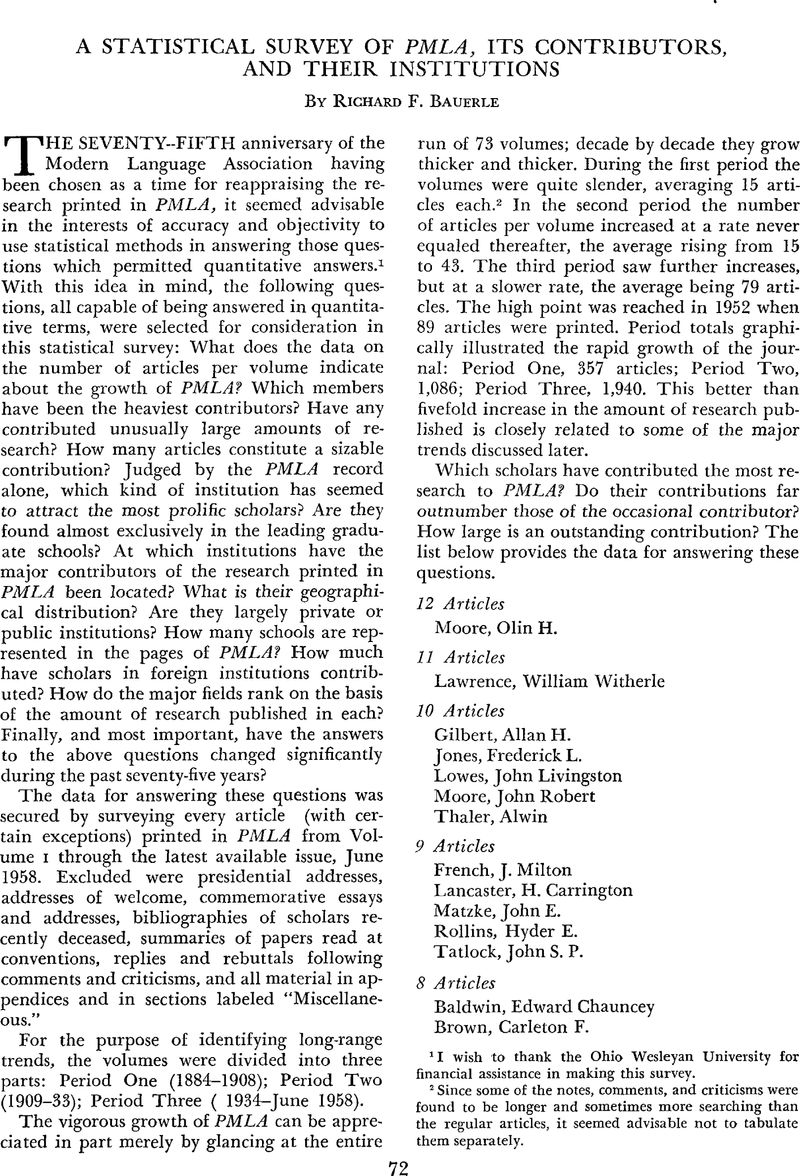No CrossRef data available.
Article contents
A Statistical Survey of Pmla, Its Contributors, and Their Institutions
Published online by Cambridge University Press: 02 December 2020
Abstract

- Type
- Other
- Information
- Copyright
- Copyright © Modern Language Association of America, 1958
References
The data for answering these questions was secured by surveying every article (with certain exceptions) printed in PMLA from Volume i through the latest available issue, June 1958. Excluded were presidential addresses, addresses of welcome, commemorative essays and addresses, bibliographies of scholars recently deceased, summaries of papers read at conventions, replies and rebuttals following comments and criticisms, and all material in appendices and in sections labeled “Miscellaneous.”
1 I wish to thank the Ohio Wesleyan University for financial assistance in making this survey.
2 Since some of the notes, comments, and criticisms were found to be longer and sometimes more searching than the regular articles, it seemed advisable not to tabulate them separately.
3 And joint authorship of another.
4 Two articles of joint authorship counted as one.
5 In this form the list favors those whose full span of professional life falls within the years 1884-1958, but a period-by-period listing proved unwieldy without eliminating the bias.
6 Institutional affiliation was determined from the address at the end of the article or from the list of members. If neither named the institution, the article was omitted from the tabulation of institutions.
7 Cornell and Rutgers, which are neither wholly private nor wholly public, were classified according to the nature of the major share of their current income, Cornell thus being classed as private, Rutgers as public.
8 Goucher College, Johns Hopkins University and the University of Maryland are classified as “Eastern,” in order to avoid establishing a minor category “Middle Atlantic.”
9 The totals for California, North Carolina, Tulane, and Western Reserve include the figures for the various campuses and undergraduate institutions listed in parentheses in the table for Period Three.
10 The decision made in 1903 to omit the Pedagogical Section from the annual meetings is paralleled by the omission of articles on the subject in PMLA.
11 For a recent analysis of this trend see Lionel Trilling, “English Literature and American Education,” Sewanee Rev., LXVI (Summer 1958), 364-381.
12 “The Association in Review,” PMLA, LXIV, Suppl., Pt. 2 (March, 1949), 3.
13 “American Scholarship in the Field of Foreign Literatures,” PMLA, LXIV, Suppl., Pt. 2 (March, 1949), 26.
14 According to a count made by the secretary in 1957, the membership in fields of interest divided as follows: English and American 5,000; German 1,450; French 1,300; Spanish and Portuguese 600; Italian 75; Slavic 86; Scandinavian 30; miscellaneous, including Latin and the Oriental languages, 600. Only members may submit articles for consideration by the editorial committee.
15 “Executive Secretary's Report,” PMLA, LXXIII (April 1958), 17-18.
18 See “Facts of Journal Publishing,” PMLA, LXXII (Sept. 1957), vii-ix, and in the same issue, pp. 52-65, “American Journals in the Humanities: A Guide to Scope and Editorial Policy” (pp. 52-65). See also the “Editorial Policy of PMLA,” PMLA, LXXIII (March 1957), 1, and “PMLA Contributions” a note on the processing of manuscripts, PMLA, LXVIII (March 1958), iii.


